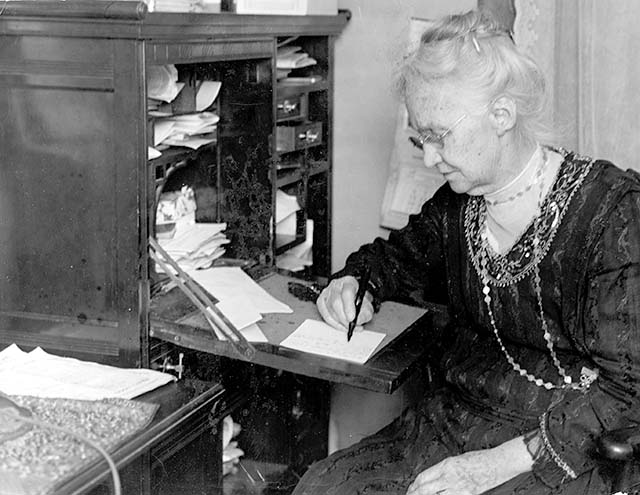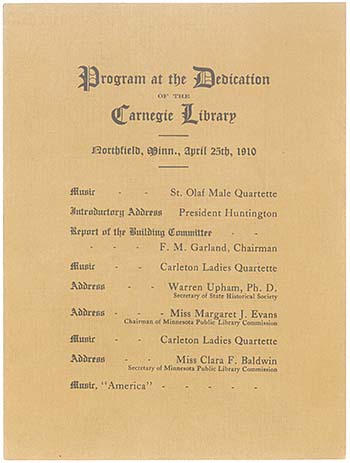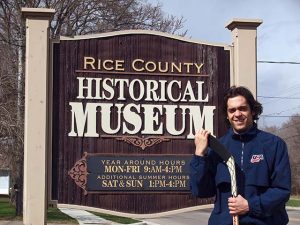
I guess I am easily entertained, because my idea of a good time is to look at microfilm of old newspapers at the Northfield Public Library. For this column, I set myself the task of seeing what Northfielders were thinking and reading about 100 years ago. So, here we go: April 1910, as shown in the two weekly newspapers, the Northfield Independent, which came out every Thursday (slogan: “The Paper that Gives the News First”) and the Northfield News, which came out on Saturdays.
“Approach of Comet” was the headline for the Northfield News of April 2, 1910. “Famous Object which Created Universal Dread Throughout Europe. Was Visible in 1066 A.D.” The director of the Carleton Observatory gave detailed information on Halley’s Comet (including diagrams) which was approaching the earth in a few weeks. The comet was said to appear every 76 years on average.
In 1909, America’s beloved humorist and author Mark Twain wrote, “I came in with Halley’s Comet in 1835. It is coming again next year (1910), and I expect to go out with it. It will be the greatest disappointment of my life if I don’t go out with Halley’s Comet. The Almighty has said, no doubt: Now here are these two unaccountable freaks; they came in together, they must go out together.” On April 21, 1910, Mark Twain died and Northfielders mourned, along with the rest of the country. According to Northfield lore (which cannot be documented), Mark Twain came to Northfield in 1886 and signed the guest book of the YMCA Building (now the Northfield Arts Guild at 304 S. Division St.). It was said that he signed in as “The Professional Tramp” and stayed at the Archer House while researching his book, “Life on the Mississippi.”
The town of Northfield mourned another death that April, of Joel P. Heatwole. Heatwole had become publisher of the Northfield News in 1884, building it into a leading weekly in the state. He had served as mayor of Northfield and in Congress. His obituary in the News of April 9 called him “public spirited and progressive,” and an “earnest advocate” for the betterment of Northfield.
The April 2 News included an “unfortunate accident” when a runaway horse collided with an auto on Division Street and a strange incident involving a “rosy cheeked, curly haired boy of about four years of age” who had boarded the north-bound Milwaukee train and was “entirely unknown to any of the passengers.” After his “running around without anybody to look after him caused some comment,” the boy was put off at Northfield in charge of the station operator. The boy was unable to give his destination or say where he had come on board, only that his name was Roy or Leroy. The boy “gave vent to his resentment for not being allowed to continue his trip.” Finally, after messages were sent, it was found his name was Roy Jeffries from Austin. Roy was taken back to Austin by rail, in the charge of a conductor.
Another train incident was reported in the News of April 23 under the headline, “A Sagacious Canine.” The tale was set forth as follows: “A desire to return to its old home at Waterford from Randolph last Tuesday brought out the intelligence of a bull dog belonging to Carl Bill. The dog, unaided, jumped on a Great Western passenger train Tuesday morning and rode in the smoking compartment to Waterford, where it calmly walked out of the train and went to the home of its master. The train made one stop at Wallace, but the animal made no move to leave the train at that point. The whereabouts of the dog was not known at Randolph until a telephone message was received from Waterford.”
On April 23, the News wrote about an article that had appeared in the Owatonna-Chronicle Journal. The story from Owatonna began, “Ragged, disheveled, dirty and tired, two young men presented themselves before Alvin Peterson, day telegraph operator at the Rock Island depot, early Wednesday morning and offered him their rings and watches for tickets to Northfield, where they claimed to be students at Carleton College.” M.S. Kjorlaug and Mark Frazer told him they had been bound and gagged “by fellow collegians, who were initiating them into one of the college societies.” They had been spirited off to Owatonna by train and tied to a tree in the countryside near Mineral Springs Road after being dressed in “rough clothing” and relieved of their money. The perpetrators intended them to be forced to “bum their way back to Northfield.”
A nearby farmer’s son heard their cries for help and released them. They found their way to the Rock Island depot where Mr. Peterson staked them to tickets back to Northfield. The perpetrators had spent the night in the city and returned on a train, which left Owatonna hours after the two victims had “joyously boarded the early north-bound train, thereby beating their captors back to Northfield.” The account continued that the farmer, after hearing what had happened from his son, reported it to the police. The police chief and sheriff hurried to the scene in an attempt to catch the “desperate characters” at large and were much chagrined to discover it was “nothing but a college prank.”
The News gave its own version of the events in the April 23 article, which was similar to the Carletonia account of April 28. The title of the story from Carleton was, “Abduction Causes Stir, Newspapers Exaggerate Story of Class Scrap.” Both of these sources say that members of the Carleton freshmen class had caught two sophomores, Kjorlaug and Frazer, and took them by rail to Owatonna for a prank. Although their hands were bound with adhesive tape for the ride, the sophomores did not ask anyone for aid and “went peacefully on the train.” Ten or 12 “husky freshmen” made the trip with the captives and, upon arrival in Owatonna, took the sophomores to a restaurant where they had a “fine feed” and then had their pictures taken. At this photo gallery, “the sophomores were induced to change their clothes and afterward the captors refused to return the captives their own clothing.” They all then hiked a mile and a half to a farmer’s barn for a night’s sleep in the hay. The next morning, the captives were blindfolded and “left to shift for themselves.” The two easily broke the cords on their wrists, “borrowed” tickets from the ticket agent and chugged on home “safe and sound” to meet their captors who arrived on a later train. “A large crowd had assembled and the freshmen were given the laugh.”
The account in the News ended: “The Owatonna city marshal was quite worked up over the affair…College pranks are evidently an unknown quantity in Owatonna.”
News of this “abduction” appeared in the Minneapolis Evening Journal, the Minneapolis Tribune and the St. Paul Pioneer Press and Dispatch. The story was picked up by the Associated Press, which distributed it nationally. On April 30, the Northfield News attributed the story to a cub reporter in Owatonna who developed the habit of “painting minor incidents in the most brilliant or lurid hues” in order to more easily sell his story, ignoring facts. The news writer harrumphed that the lengthy editorials that had been written on this affair “reflect on a measure on the fair name of the Northfield college.” This thought had also been expressed by the Northfield Independent on April 28: “It does not make a good advertisement for Carleton College.”
I assume some Northfielders were amused by this local prank. They most certainly were amused by the naval hoax in England that the Independent wrote about on April 21. Four “jokers,” with the aid of elaborate makeup, successfully passed themselves off as Abyssinian princes and were accorded royal honors as they were shown over the battleship Dreadnought by an admiral and other officers. “At every fresh sight,” said the story, the supposed princes “murmured in chorus, ‘Bunga, bunga!’ which, being interpreted, meant ‘Wonderful, wonderful!’ besides other gibberish learned beforehand.” Their disguises were so good that one of the “princes” was actually a woman. This story ended with the rumor that the same hoax would be tried in the United States.

 The culminating event of this month in 1910 was undoubtedly the dedication of the Carnegie Library (now the Northfield Public Library) on April 25 at the corner of Division and Third streets. Between 130-150 people were present at the dedication. The cost of the building, according to the Northfield News of April 30, was $11,018.94, with $10,000 of that provided by philanthropist Andrew Carnegie. Author and former Carleton professor George Huntington, president of the library board, gave thanks to all donors and spoke of the history of the project, including “the difference of opinion about the location of the building.” Today, he said, “was the day when all should forget their differences and agree to agree.” There were several addresses, including one by Margaret Evans, chairman of the state library commission and Carleton Dean of Women from 1874 to 1908. Evans said, “The housing of the library is not alone for today, but we rejoice for the everlasting influences.” Clara Baldwin, secretary of the state library commission, told the crowd that “of the 40 libraries built in the state in the past ten years none are more satisfactory.” Music was provided by the St. Olaf Male Quartet and the Carleton Ladies Quartet. Books were to be moved the next week from the old library in the YMCA Building to the new red brick library, which this year is celebrating its centennial.
The culminating event of this month in 1910 was undoubtedly the dedication of the Carnegie Library (now the Northfield Public Library) on April 25 at the corner of Division and Third streets. Between 130-150 people were present at the dedication. The cost of the building, according to the Northfield News of April 30, was $11,018.94, with $10,000 of that provided by philanthropist Andrew Carnegie. Author and former Carleton professor George Huntington, president of the library board, gave thanks to all donors and spoke of the history of the project, including “the difference of opinion about the location of the building.” Today, he said, “was the day when all should forget their differences and agree to agree.” There were several addresses, including one by Margaret Evans, chairman of the state library commission and Carleton Dean of Women from 1874 to 1908. Evans said, “The housing of the library is not alone for today, but we rejoice for the everlasting influences.” Clara Baldwin, secretary of the state library commission, told the crowd that “of the 40 libraries built in the state in the past ten years none are more satisfactory.” Music was provided by the St. Olaf Male Quartet and the Carleton Ladies Quartet. Books were to be moved the next week from the old library in the YMCA Building to the new red brick library, which this year is celebrating its centennial.
Margaret Evans and George Huntington, participants in the 1910 library dedication, made headlines when they married on Nov. 7, 1914. She was a first-time bride at 72 and he was a 79-year-old widower. They sailed off from San Francisco to Hawaii for an extended honeymoon, surprising everyone in Northfield. But that’s a story for some other month!
Thanks to Carleton archivist, Eric Hillemann, and to the Northfield Public Library. Happy anniversary!






